The post Pain Under The Right Rib Cage appeared first on Food Pyramid.
]]>The Rib Cage
If you look at the image below, you can see that the rib cage protects a few organs. You can also see which organs that are close to the right rib cage area.
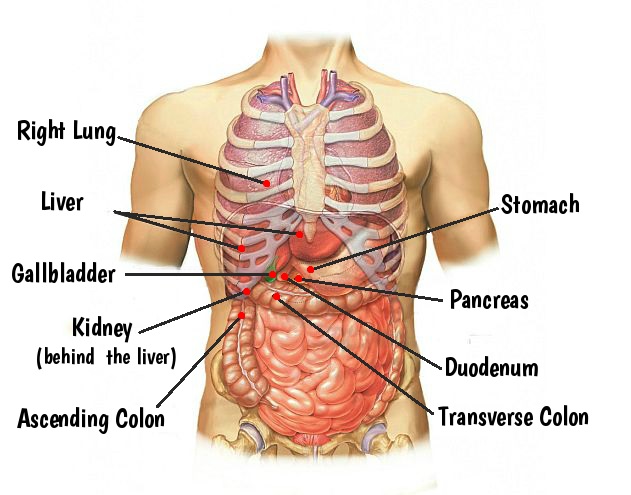
Some of the above organs can actually cause a minor discomfort or even a constant pain if they are not in good health. We will take a closer look into how the organs can cause pain, but also cover other possibilities that may cause discomfort in the right rib area.
Causes of pain under the right rib cage
Sometimes there are infections and abnormalities that can appear in different organs. The affected organs will complain by manifesting different unpleasant symptoms. Pain is one popular symptom, which can be felt as a dull, sharp, or a stabbing pain. Even if you just feel a pressure under the right rib, or a constant pain, it is a symptom that there is something wrong going on.
Let’s take a closer look into the organs that can cause problems.
Colon Problems
Some parts of the colon lie just below the right rib cage. The transverse colon, the hepatic flexure, and the ascending colon are the ones that can be affected. Diseases related to those parts can cause pain under the right rib cage, and they include:
- Right Colonic Diverticulitis – This is a condition caused by an inflammation of the pouches formed in the wall of the colon called diverticula. You may experience a sharp pain under the right rib cage. This condition seem to appear more in Asian countries.
- Gases – Trapped wind can cause pain under the right rib cage when breathing sometimes. The pain is due to the accumulation of gas causing the colon to swell. The pain can occur in the hepatic flexure, which is the part where the colon bends.
- Irritable Bowel Syndrome – this chronic condition affects your bowel movement. Bloating, cramping pain, and abdominal pain are common symptoms. The discomfort levels can vary.
- Inflammatory Bowel Disease – This means that there is an ongoing inflammation of the digestive tract. Ulcerative colitis and Crohn’s disease cause chronic inflammation of the colon wall. This can result in dull aching pain in the right side of the rib cage.
Gallbladder Problems
The gallbladder stores bile needed for digestion of food. It is positioned under your liver and close to the end of the ribs. It is not uncommon that you can feel a dull pain under the right rib cage due to the following conditions:
- Cholelithiasis – this is when stones build up in the gallbladder. Gallstones occur due to the sediments of bile formed in the gallbladder. You will feel pain under the right rib cage when the stones obstruct the bile duct. Pain is also felt in the back.
- Cholangitis – this is a serious infection of the bile duct, which can be caused due to the gallstones blocking the passage of the bile. Expect feeling a sharp pain.
- Gallbladder cancer – this is the spread of a malignant tumor. It can cause mild to moderate pain in the upper right abdomen area in the late stages of the disease.
Upper Gastrointestinal Tract
Parts of the upper gastrointestinal tract include the food pipe, stomach, and duodenum. Disturbance in those organs can also cause pain under the right rib cage.
- Acid Reflux – This condition is also known as Gastroesophageal reflux disease (GERD). This is when the stomach content runs back up to the food pipe (esophagus). It can cause a burning sensation in the throat, nausea, vomiting breast discomfort, and also cause a sharp or tender pain along the right rib cage.
- Ulcers – Stomach and duodenal ulcers are sores in the lining of the organs. The duodenum is a part of the small intestine directly connecting to the stomach. That part is the one that actually is located closer under your right rib. The ulcers can sometimes cause severe pain under the right rib cage.
Kidney Problems
The right kidney is situated behind the liver. Diseases affecting the right kidney can cause pain in the flank and also below the rib cage. The cause of pain under the right rib cage and back due to the disorders affecting the kidneys include:
- Kidney Stones – pain under the right rib cage can actually occur due to the build up of kidney stones that obstruct the flow of urine. Small stones can pass through the ureters causing a flank pain that may radiate from the back to the front of your right rib cage.
- Kidney Infection – bacteria can cause infection in the right kidney resulting in sharp burning pain under the right rib cage. Other common symptoms would be fever, flank pain, and pain while passing urine.
- Polycystic Kidney Disease – caused due to presence of cysts in the kidney. It is a genetically-linked disease, and as the cyst grows it can cause a sharp or dull pain under the right rib cage.
Liver Problems
The liver, being the largest organ in the abdominal cavity, occupies a large area under the right rib cage. Pain associated with the liver include:
- Trauma – a blunt trauma to the abdominal area can cause a stabbing pain under the rib cage. In rare cases, an injury can also occur after a laparoscopic liver surgery.
- Alcoholic Liver Disease – Damages to the liver due to the abuse of alcohol can lead to pain in the liver. Alcoholic hepatitis can cause constant pain under the right rib cage, especially during the initial stages of the disease.
- Viral Hepatitis – this caused by an infection of the liver and can cause discomfort under the right rib cage together with nausea, vomiting, loose motions and loss of appetite.
- Hepatic Steatosis – this condition happens due to the accumulation of fat in the liver, which is also called fatty liver disease. It is often linked with obesity, high levels of cholesterol, and hypertension. This condition can cause an aching pain below the rib cage.
- Pyogenic Liver Abscess – a rare acute condition that occurs due to the accumulation of pus. It develops due to an infection in the liver and causes pain along the lower right rib cage.
- Liver Cancer – when cancer grows in the liver during the later stages of the disease, you can experience pain.
- Hepatitc Cysts – are sacs filled with fluid, and when the cyst becomes large they can cause pain on the lower part of the rib cage.
- Cholestasis – This is a disturbance that happens when the flow of the bile from the liver slows down. It could be due to several reasons, including during pregnancy when the pregnancy hormones are very high.
Lung Problems
Pain under the right rib cage may occur due to the conditions affecting the right lungs, and the plural membrane covering the lung. There are many different pulmonary problems that can actually cause pain, to name a few:
- Pleuritis – This is when the lining of the lungs become inflamed. You will likely feel a stabbing pain when you cough or when you breath deeply.
- Lung Abscess – This is when a pocket of puss is created in the lungs do to an infection of the tissues. This can occur due to pneumonia, abnormalities of the lungs, or other infections.
- Shingles – This is a type of herpes that develops into rash of blisters along the ribs. You will likely feel itching and pain on the right side of the rib cage even before the rash appears.
Pancreas Problems
The pancreas is a gland behind the stomach close to the duodenum. Like any other organ, it can also get affected by different unwanted health conditions. This can in turn be the cause of pain under the right rib cage.
- Pancreatitis – This is a condition when digestive enzymes start tearing apart the pancreas. Nausea, vomiting and pain in the abdomen just under right rib cage are symptoms to look for.
- Pancreatic Cancer – This type of cancer is hard to catch in the early stages because the pancreas is hidden behind organs. Therefore, it is hard to discover tumors during a regular routine exam. It is said that 1 in 4 pancreatic cancers are caused by smoking.
Other things causing pain under the right rib cage
Pain during cardio
Some people may feel sharp pain under the right rib cage when running or doing other cardio exercises. The exercise-related pain is described as a stabbing and cramping pain felt under the rib cage. The pain usually subsides after taking rest. The actual cause to this phenomena is still unclear according to studies.
Painful rib syndrome
This is an uncommon inflammatory disorder where the upper ribs are affected. The pain is felt where the ribs connect to the breastbone (sternum). If you also feel pain in the sternum, there could be other underlying causes.
Adhesions
This is when internal organs and tissues stick together due to scar tissue. Organs are normally slippery and they will not stick, but if you have undergone a pelvic or abdominal surgery, it may have caused an injury to your organs. Pain can come months or years after surgery.
Fractures and Muscles
A bruised or fractured rib will certainly cause an intense pain on any part of your rib cage. Also, intense exercises can lead to muscle strains causing pain in the right rib cage area.
Pregnancy
A woman’s body needs to cope with at lot of things during pregnancy. Many things can cause pain under the right rib cage during pregnancy. Pain can come from the gallbladder, growing uterus, baby kicks, rib cage spreading, implantation, and a few other things.
Treatment and Diagnosis
Diagnosis of the underlying cause of having pain in the right rib cage area can help in initiating an appropriate treatment for the condition, which will help to get rid of the symptom. The cause can be detected with the help of evaluation of the symptoms including the type of pain, its nature, and the history of alcoholism or injury, physical examination, and diagnostic tools like X-ray, CT scan, and ultrasonography.
If you suspect that you have more than a workout pain, you may want to consult your doctor and set up an appointment quickly. It is important to address the problem quickly, and not wait until the the symptoms escalate.
The post Pain Under The Right Rib Cage appeared first on Food Pyramid.
]]>The post Sneezing After Eating appeared first on Food Pyramid.
]]>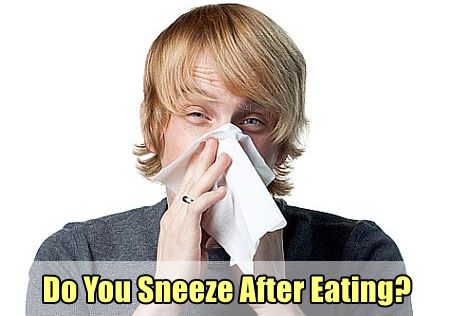
Some people sneeze after plucking their eyebrows while some sneeze when exposed to the bright sunlight. Basically, sneezing occurs when the nerves in the mucous membrane lining the inner wall of our nostrils are irritated or stimulated. Sneezing is the body’s response to the cause of irritation with an effort to eliminate it from the body through the forceful act similar to blowing the nose. It is a reflex action that is beyond our control.
Let’s take a closer look to the different factors that can irritate the nasal mucosa and cause sneezing after meals.
Causes of Sneezing After Eating
Food Allergies
The most common cause of meal-related sneezing is food allergies. Many people complain of sneezing after eating chocolate, wheat, peanuts, seafood, milk, and eggs due to the heightened sensitivity of the body to them. The body triggers an immune response when a person eats these foods resulting in a series of symptoms usually beginning with sneezing.
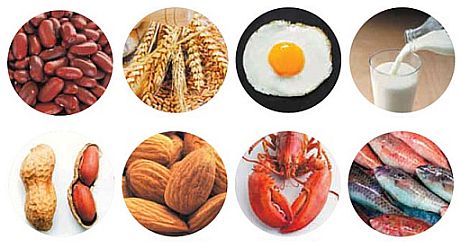
Certain foods may cause sneezing and runny nose after eating
Eating too much
Sneezing after eating too much can be attributed to a distended stomach. When you eat too much beyond the usual capacity of your stomach, its walls are stretched. This causes irritation of the nerves within the mucosal lining of the stomach causing sudden sneezing fits after eating. This peculiar condition is called Snatiation, which is thought to be genetically linked. People with this trait often sneeze incessantly when their brain registers a full belly. The sneezing after overeating happens irrespective of the type of food ingested. It can be controlled by simply avoiding heavy meals, eating smaller portions, and eating more frequent meals.
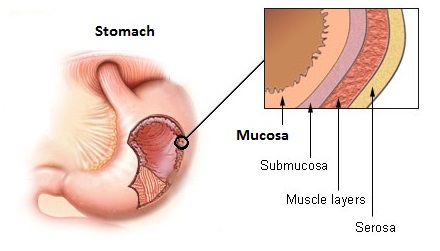
Showing the stomach and the mucosa lining
Airborne Causes
A person may sneeze after eating due to allergies hidden in the environment causing what is called allergic rhintitis. What does that mean? You see, particles may float in the air that can cause allergic reactions. You might get sneezing attacks in an environment with dust, pollen, perfumes, detergents, smoke, and fur of pets. These “allergic triggers” may be what cause sneezing after eating sometimes. Symptoms can often be more severe than just sneezing. To avoid this from happening, you need to study your environment and see if you find a common factor that triggers the sneezing every time you eat.
Gustatory Rhinitis
Gustatory rhinitis is a non-allergic rhintitis causing congestion in the nose, continuous sneezing, and a running nose after meals. It usually occurs due to certain foods like ice creams, cold drinks, spicy foods, and alcohol as these can trigger a reaction in the nervous system that causes swelling of the nasal mucosa. People with allergic rhinitis or who smoke are according to a survey more likely to experience gustatory rhinitis symptoms.
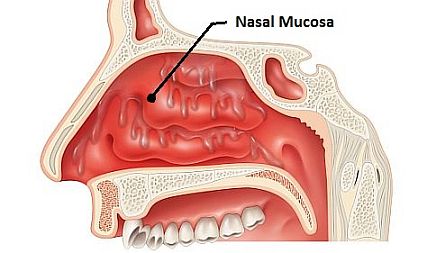
Location of the nasal mucosa.
Tips to Prevent Sneezing After Eating
Keep a food diary – People who develop sneezing after eating due to an allergy do not get the symptoms after all meals. Hence, if you are experiencing the bouts just occasionally – that is when you have consumed or been exposed to the allergens – the cause is most likely an allergy. It can be avoided by keeping a food diary in which you can record the foods you eat. This will help you observe a pattern between the ingredients, food types, or methods of cooking and your episodes of sneezing such as sneezing after eating bread or nuts. This will help you identify substances that could be the allergen for you. The next step is simple; you just need to avoid those allergens!
Change Eating Habits – If you notice that the attacks are accompanied by a feeling of fullness in your stomach, then you can try eating smaller meals at frequent intervals. This will prevent the bloating of your stomach and the resulting stimulation of the nervous system to sneeze.
Nasal Irrigation – Irrigate your nose with sterile water using a squeeze bottle or bulb syringe. A daily nasal lavage will help to flush out the irritants and prevent the allergy symptoms.
Drink Water – Increase your water intake to keep your body well hydrated. This will prevent the dryness and irritation of the mucous membranes.
Inhale Steam – A hot bowl of water is enough for this. Just sit over the bowl and use a towel over your head. This can loosen the mucus in the nose and reduce the congestion.
Keep It Clean – Keep the dining area clean and free from suspected allergens like dust.
See a Doctor – It is obviously a good thing to consult with doctor if you feel that you can’t control the discomfort of sneezing after eating. The doctor may prescribe you a nasal spray or maybe suggest you to do a food allergy test.
It can be quite embarrassing to sneeze uncontrollably when you are eating out at a restaurant or even at home with anyone around. Though this is not a dangerous symptom or a sign of any serious illness, it can cause a lot of discomfort and inconvenience. You can easily get rid of sneezing while eating by identifying which of the above-mentioned factors is causing irritation or stimulation of the nasal mucosa and taking steps to avoid them.
The post Sneezing After Eating appeared first on Food Pyramid.
]]>The post Lump Behind the Ear appeared first on Food Pyramid.
]]>Causes of Lumps Behind the Ear
Dermatitis
The build-up of dead or waxy skin cells as a result of dermatitis can cause a lump behind the ear. These signs are usually accompanied by the flaking of dry skin, inflammation, swelling, and redness. Seborrheic dermatitis is a common form of dermatitis that can cause a lumps behind the ears, especially in patients with epilepsy, Parkinson’s disease, and AIDS. It is usually triggered by a stressful situation, or climatic changes. Dermatitis can also occur due to the neurological conditions, or fungal infections.
The ear lumps caused by dermatitis can be treated with topical creams and lotions containing corticosteroids like hydrocortisone and betamethasone. These medications help to reduce the discomfort and itching. The lumps caused by a fungal infection can be managed with the help of oral and topical antifungal medications like Ciclopirox and Ketoconazole. A soothing bath using uncooked oatmeal or baking soda can also assist in treating bumps behind the ear.
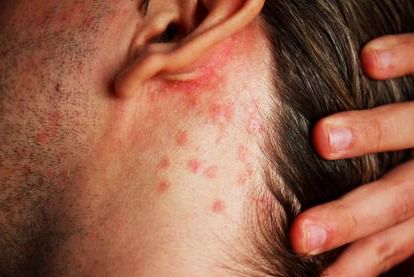
Seborrheic dermatitis with small lumps behind the ear.
Allergies
An allergy is another factor for what causes a lump behind the ear, especially a painful and itchy one. The swelling may occur due to an allergy from ear accessories, perfumes, or even cosmetics. The best way to prevent this is to identify the allergen and then, stop its use. The allergen can be identified by keeping a diary in which you can note down the occurrence of the symptoms and the use of particular cosmetic, jewelry or perfume and then, relate the both to know what exactly caused the lump behind the ear and itching. Insect bites can also cause allergic reactions, and what may at first feel like an innocent pea sized lump can swell up to a big bump.
Swollen Lymph Nodes
Lymph nodes can cause lumps behind the ear, which are soft, tender, and painful. An enlarged lymph node can be a sign of an infection in the ears or the area surrounding them. Some other conditions like Streptococcal sore throat, common cold, and sinusitis can also cause the lymph nodes to swell. In case of a generalized infection, there can be lumps behind both ears along with severe weakness, and fever.
A lump behind the ear caused by these infections can be managed using antibiotics, and anti-inflammatory medications. The anti-inflammatory medications help to relieve the pain and swelling while the antibiotics destroy the bacteria responsible for the infection. Sore throat, sinusitis, and common cold can be treated by gargling with warm salt water.
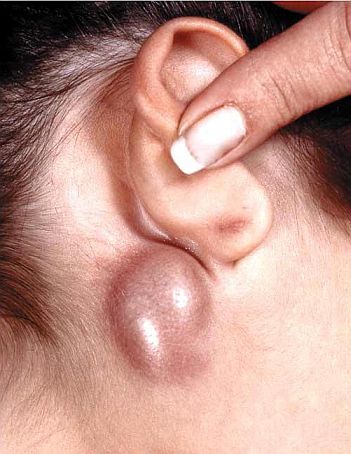
Big lump behind the ear caused by a swollen lymph node
Mastoiditis
Another reason for what causes lumps behind the ear is mastoiditis. It is an infective disorder affecting the mastoid bone located behind the ear. The infection is usually secondary in nature that has spread from an infection in the middle ear or throat. The infection results in the formation of a swollen lump behind the ear by causing inflammation and structural disruptions in the mastoid bone. It may also cause redness, suppuration, ear pain, and swelling along with fever, irritability, headache, and hearing loss.
Mastoiditis can be treated using oral or intravenous antibiotics like Ceftriaxone together with antibiotic ear drops. Some people say that putting few drops of a strained mixture of garlic and olive oil into the ear can also help to relieve the sore lump behind the ear. In severe cases of mastoiditis, surgery is needed to remove the lump behind the ear.
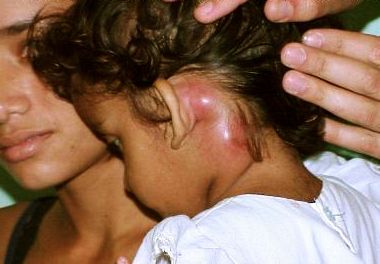
Child with mastoiditis causing a painful lump behind the left ear.
Acne
Acne is the most common skin condition affecting young adults at the age of puberty. It leads to the formation of whiteheads, blackheads, papules, pustules, and small nodules on the skin. In some cases, a lump on the skull behind the ear can be a simple acne eruption. The lump is caused by the hormonal changes occurring in the body during puberty, stress, unusually high levels of androgens, an infection, or even genetic predisposition. Acne lumps can actually appear anywhere behind the ear and they are often painless.
Acne can be treated using medicines containing retinoid (A form of Vitamin A) or benzoyl peroxidase. In case of severe hormonal imbalance, an anti-androgenic hormonal therapy can be prescribed. Oftentimes, this type of condition goes away by itself, just make sure you wash and clean the infected area thoroughly.
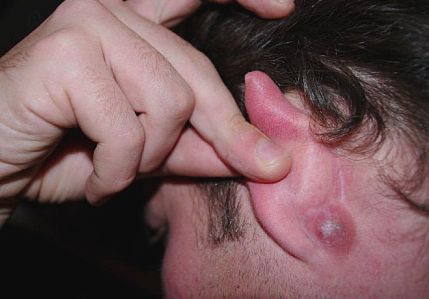
A pimple behind the ear
Cysts
A large or a small painful lump behind the ear can be a cyst. Cysts are fluid-filled bumps that are formed due to several reasons. They are sometimes formed due to the blocked sebaceous glands. These cysts are usually accompanied by the build-up of sebum, in which case they are referred to as a sebaceous cyst. A cartilage piercing bump behind the ear can be the result of a cyst that has burst. An epidermal cyst is made of accumulated keratin, in which case the lumps are formed behind the ears as well as the other body parts. These cysts may get infected and fester.
A cyst can be treated using anti-inflammatory agents, antibiotics, and hydrogen peroxide gels. Warm compresses and heating pads can help to drain the pus and provide relief from the pain. Surgical excision of the cyst or laser therapy may be recommended in severe cases.
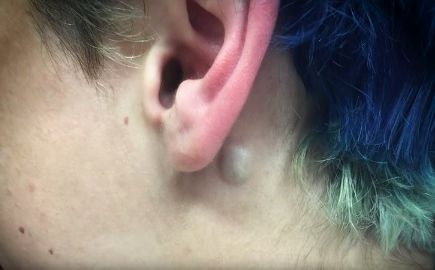
A small cyst close to the earlobe.
Abscess
An itchy lump behind the ear may be due to an infection that has turned into an abscess. An abscess is an enclosed “capsules” with a wall that is filled with pus. An abscess can also develop around a foreign body or from an existing cyst. The treatment involves the use of antibiotics or a surgical excision.
Benign Tumor
A benign tumor may become evident as a lump behind the ear. The swelling is usually soft, painless, and movable. The tumors that can cause a hard painful lump behind the ear include those arising from the salivary glands that have spread to the part behind the ears. These painless tumors may or may not increase in size. A tumor that grows on the mastoid bone is called cholesteatoma. This malformation can destruct the tissues near the ears and cause hearing loss, tinnitus (an abnormal ringing or buzzing sounds in the ears), dizziness, and drainage in the ear.
A benign tumor pose a lower health risk than malignant tumors. Benign tumors behind the ear may grow slowly, but can disappear on their own. Surgical excision may be required for the lump that hurts and makes the jaw movement difficult.
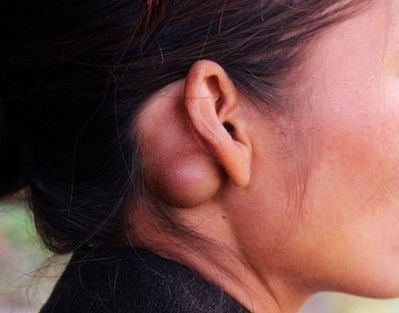
A tumor behind the ear may grow slowly over time.
Cancer
A lump behind the ear can be a malignant growth due to the cancer of salivary glands or the skin. These lumps are usually painless and can grow larger over time. They can be treated with chemotherapy drugs, radiation therapy, surgical excision or a combination of these. The treatment option is based on the stage of the cancer and the extent of its spread.
Lipoma
Lipoma is a swelling caused by the growth of fatty tissues and results in the formation of a lump. The fatty lump often forms between the layers of the skin. These lumps are harmless and can sometimes clear up spontaneously, but in general they tend to grow very slowly. If the lump behind the ear grows or feels bothersome, surgical removal may be an option to opt for.
Hemangioma
Hemangioma is a noncancerous growth formed due to the abnormal collection of blood vessels. This condition is more common in infants than in adults. It appears as a red/purple bump and is usually found on the skin and the organs, particularly the liver. In rare cases, hemangioma may form behind the ear but they are in most cases benign and harmless.
An early detection of the hemangioma can help to initiate the treatment before any complications arise.
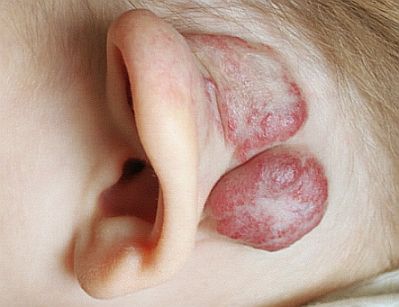
Baby with hamangioma
Keloids
Keloids form when scar tissue overgrows due to a skin injury. This type of condition can form on any part of the body, but when it comes to the ear area, it is often due to piercing. If you have had your ear lobs pierced or an ear cartilage piercing and you are noticng a bump behind the ears, this can be the cause.
Keloid lumps behind the ear are not dangerous and are primarily a cosmetic concern. They can be treated with steroid injections, cosmetic surgery, and compression.
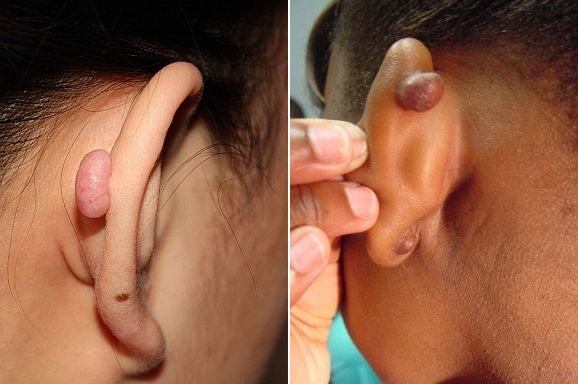
Cartilage piercing bump behind the ear together with a pea sized lump behind the ear lobe.
The post Lump Behind the Ear appeared first on Food Pyramid.
]]>The post Reser’s Fine Foods Recall April 2016 appeared first on Food Pyramid.
]]>The recall was issued due to a notification received from one of their suppliers who provides the ingredients used in the salads. It was stated in a press release that Listeria monocytogenes could be present in the products. It seems like the problem lies in a batch of onions used in the manufacturing process of the salads may carry the Listeria bacteria. The bacteria can cause serious problems in young children, elderly people, and pregnant woman.
A total of nineteen different products are affected by this recall and they are both retail products and foodservice products, which are used for commercial use. Some of the affected salads include:
- Reser’s Deviled Egg Potato Salad
- Reser’s Potato Salad
- Reser’s Macaroni Salad
- Stonemill Kitchens Classic Potato Salad
- Safeway Deviled Egg Potato Salad
- Safeway Classic Potato Salad
- Safeway Tuna Salad
- Walmart Redskin Potato Salad
- Savemart Potato Salad
- Sysco Elbow Macaroni Salad
- Safeway Tuna Salad
- FSA Potato Salad
Note that the above list is just the type of salad affected, you still need to check for the UPC code, its size, and expiration date. For that, you should visit FDA’s website for a complete list together with images of the products.
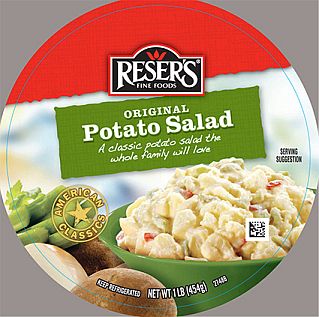
If you are in the possession of any of the products from the FDA’s website, you are urged not to consume them. Instead discard them or claim a refund. For more details you should call 1-888-257-7913, which is the number to Reser’s Fine Foods Consumer Hotline.
This is not the first time Reser’s Fine Foods is recalling food due to possible Listeria monocytogenes contamination. In December of 2015 a potato salad was recalled. Another incident was in 2013, where lots of products had to be recalled.
The post Reser’s Fine Foods Recall April 2016 appeared first on Food Pyramid.
]]>The post Bumble Bee Tuna Recall March 2016 appeared first on Food Pyramid.
]]>1. Label UPC: 8660000020 – 5oz Bumble Bee Chunk Light Tuna in Water
2. Label UPC: 8660000021 – 5oz Bumble Bee Chunk Light Tuna in Oil
3. Label UPC: 8660000736 – 4 Pack of 5oz Bumble Bee Chunk Light Tuna in Water
If you have tuna with matching UPC codes, visit Bumble Bee’s website to see full list of the specific can codes affected.
The tuna is being recalled voluntarily by Bumble Bee Foods. This is done because of some packaging deviations discovered in a co-pack facility, which is not own or operated by Bumble Bee Foods, LLC. The deviation seem to have been discovered in the sterilization of the tuna. This is an important part of the whole tuna processing. If the sterilization process is not done correctly, it could lead to serious health problems if the tuna is consumed. No reports of illnesses have yet been reported in connection with the related products.
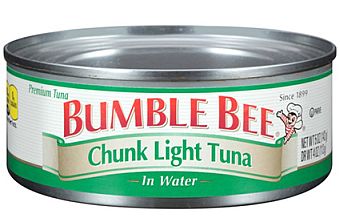
Bumble Bee Foods will in total recall 31,579 tuna cases. The tuna was produced last month and distributed nationwide. Bumble Bee, the FDA, and the co-packer is working closely together organizing the removal of the tuna from the stores. If you have bought any tuna with matching can codes that are being recalled, you are advised to throw them away. For reimbursement, you should retain the label and contact Bumble Bee’s Consumer Affairs team.
This is not the first time Bumble Bee Foods recalls tuna. In 2013, a voluntary recall was issued for “Chunk Light Tuna” and “Chunk White Albacore”.
The post Bumble Bee Tuna Recall March 2016 appeared first on Food Pyramid.
]]>The post Celebrities with Heterochromia Iridis appeared first on Food Pyramid.
]]>It might be rare to see people with a set of different eye colors, but heterochromia of the eyes does not only manifest in having two different eye colors. There are three different types of heterochromia, which are: complete (two different eye colors), sectoral/partial (patches of colors), and central heterochromia (radiating from the pupil).
Diving in to the world of superstars. Are there any celebrities with heterochromia? Let’s take a look at some famous people with heterochromia, and which type of it they have.
Celebrities with Complete Heterochromia
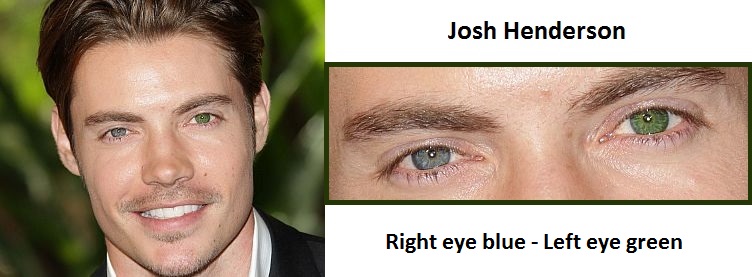
Josh Henderson, the actor who played J.R in the revival of the Dallas TV series, was born with complete heterochromia iridis. His right eye is blue, and his left eye is green. Some gossip sites state that the actor is nearly blind in his left eye without a contact lens.

If you are into Major League Baseball you might know about Max Scherzer. He is a professional baseball pitcher for the Washington Nationals. He was born with both eyes blue. However, when he was four months old, one of his eyes changed to green. Within a year, the green eye changed color again to brown, according to an interview with Mr Scherzer’s mother.

Tim McIlrath is an American punk/rock musician and lead vocalist for the band Rise Against. His left eye is blue and his right eye is brown.

Shawn Horcoff is a Canadian born professional hockey player currently playing for the Dallas Stars, but played for many years for the Edmonton Oilers. His complete heterochromia manifests in having the right eye brown and left eye green.
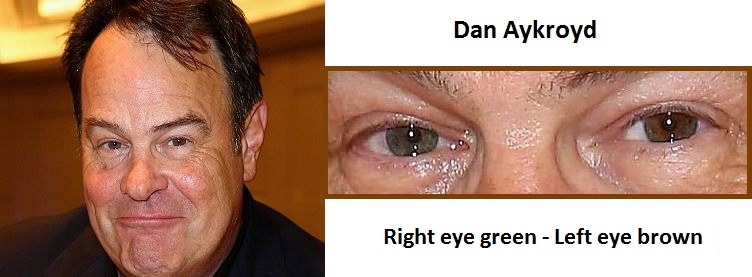
Dan Aykroyd is a famous comedian and best known for his work in the movies ”The Blues Brothers” and “Ghostbusters”. He was also born with complete heterochromia iridum. His right eye is green, and his left eye is brown.
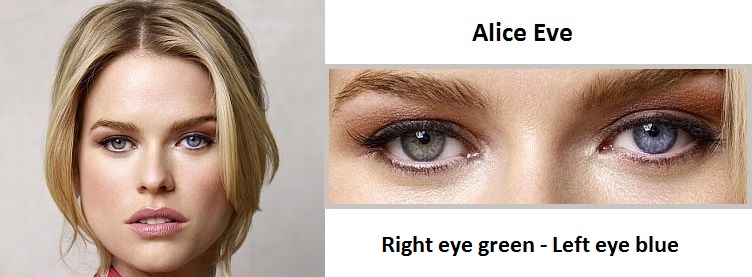
Alicia Eve is a British born actress, which you might have seen in movies like ”Star Trek Into Darkness” and “Before We Go”. This is another celebrity with different eye colors, having her right eye green and her left eye blue.
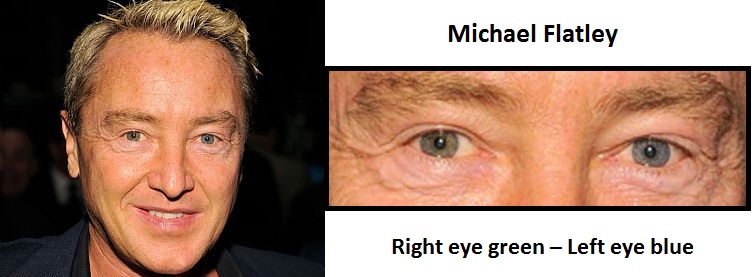
Michael Flatley is an Irish born entertainer and famous for his Riverdance shows. His right eye is green and his left eye blue.

Cricket fans should know about this guy. The Australian born Shane Warne is often regarded as one of the best cricketers in history. He has a set of very vibrant eye colors. Left eye in a green/yellow color and his right eye in light blue.

Russin born Ilya Kovlachuk was a 1st overall pick in the NHL draft of 2001, and spent most of his career with the Atlanta Trashers. He is still active but he is now playing for a Russian hockey team. His left eye is dark brown and his left eye is dark hazel.

Mila Kunis is an actress that you might know from the Oscar award winning movie “Black Swan”. Although she might not technically have complete heterochromia, she do has different eye colors. Her right eye is green, and her left eye is hazel. Her different eye colors developed while struggling with chronic iris inflammation, leaving her almost blind in one eye for several years. However, to correct her sight she decided to have a new lens surgically implanted. This is what can be classified as an acquired heterochromia.
Celebrities with Sectoral/Partial Heterochromia

Henry Cavill is an actor who is actually born in Jersey. Well, it is not New Jersey, but Jersey from the Channel Islands, UK. The British “Man of Steel” star was born with sectoral heterochromia. His right eye is blue and his left eye is partial blue with a sector of brown color.
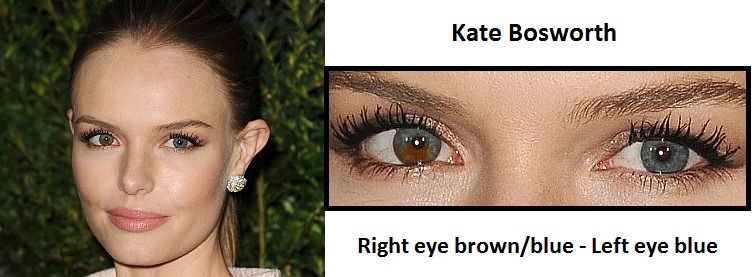
The American actress Kate Bosworth is another celebrity with partial heterochromia. However, she usually wears contacts on film to hide her true eye colors. Her right eye is partial blue/brown and her left eye is blue.

The English actor/model/musician Dominic Sherwood does also have a change in his eye colors. His right eye is blue and his left eye partial brown/blue.

Marshall Lancaster is a British actor. Some sources state he has one green and blue eye, but what can be told from images, it looks like the right eye is blue with a hazel colored sector, and his left eye is blue.

Jane Seymour of ”Dr. Quinn, Medicine Woman” and ”Live and Let Die” was born with sectoral heterochromia. The English actress’ right eye is brown/green, and the left eye is green.

The ”Legally Blonde” star Jessica Cauffiel has a green colored iris on the right eye. Her left eye is partial green and brown.

Elizabeth Berkley is an American actress famous for her role as Jessie Spano from the TV series “Saved by the bell”. Her eyes are green, but the right eye has a brown colored sector.
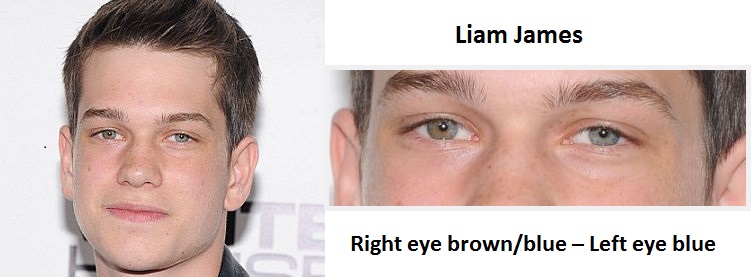
The Canadian actor Liam James – known as the young “Sean Spencer” in the TV series “Psych” – was born with sectoral heterochromia. His right eye is partial brown/blue and his left eye blue.
Celebrities with Central Heterochromia

Paris Hilton, a very famous celebrity entrepreneur, and known for being the great-granddaughter of the Hilton Hotel founder, Conrad Hilton. She has sky blue eyes with a brown shade surrounding the pupils.

The “How I Met Your Mother” and “American Pie” star Alyson Hannigan was born with central heterochromia. Both of her eyes are green with light brown inner rings.

The American actress Olivia Wilde is known for her exotic eyes. The color of her eyes are very hard to pinpoint as it shifts depending on the light. She has central heterochromia with the colors grey/blue with green inner rings.
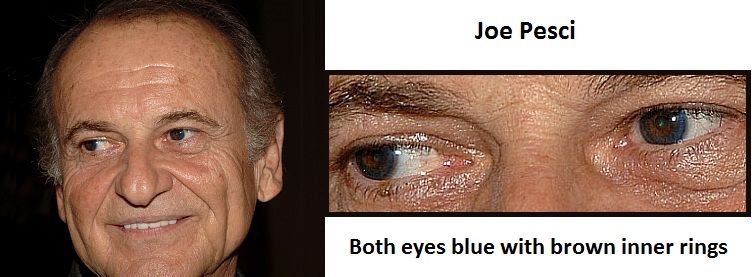
The American actor and Oscar winner Joe Pesci is famous for his roles in “Raging Bull”, “Casino”, and the “Lethal Weapon 2 -4” movies. Both of his eyes are blue with a shade of brown surrounding the pupils.

Terrence Howard is an American actor that you might remember from the movies “Hustle & Flow” and “Ray“. His both eyes are green with brown inner rings.

La La Anthony is an actress/business woman/author married to the NBA star Carmelo Anthony. Both of her eyes are grey with brown inner rings.
Other Celebrities with Heterochromia
There are several celebrities with heterochromia, but the vast majority with this condition have either partial or central heterochromia. In most cases you can hardly even notice the difference in eye colors.
Some articles mention that Christopher Walken, Simon Pegg, Kiefer Sutherland, Demi More, Benedict Cumberbatch, have two different eye colors, but that is not true. What might be true is that they might have partial or central heterochromia, and in some cases it is only a slight variation in eye color.
David Bowie is another celebrity that is often mentioned having heterochromia. He was actually born with blue eyes, but when Bowie was a teenager, he got into a fight over a girl with his best friend George Underwood. The friend was wearing a ring while punching Bowie, causing great damage to Bowie’s left eye. Bowie had to stay out of school for eight months due to operations that were needed to fix the eye. Unfortunately, the doctors couldn’t fully repair his left eye. His color vision was mostly lost, leaving him with a faulty depth perception, and a permanently dilated pupil (a condition called anisocoria). As a result, his eye colors is commonly mistaken to be different when in fact it is the dilated pupil that is causing the illusion.

The post Celebrities with Heterochromia Iridis appeared first on Food Pyramid.
]]>The post Which Country Consumes The Most Sugar Per Capita? appeared first on Food Pyramid.
]]>According to recent statistics gathered by Euromonitor International, the country that consumes most sugar is…the U.S. Yes, Americans are actually consuming a whopping 127 grams per day, beating the runner-up Germany by 23.5 grams more, according to the data provided from Euromonitor. People in the U.S seem to consume on average 2.54 times more sugar than what the World Health Organization (WHO) recommends, which currently has a recommended sugar intake of 50 grams per day. The third position on the list goes to the Netherlands with a per capita sugar consumption of 102.5 grams per day. The top consuming sugar country’s neighbor, Canada, takes the tenth position with a sugar consumption per capita of 89.1 grams a day.
As mentioned earlier, WHO guidelines addresses the sugar consumption in the world by limiting the maximum intake of added sugars to 50 grams per day. WHO is currently pushing to reduce the recommended intake to 25 grams, but it is still under works. Looking at the U.S. Dietary Guidelines for Americans, they seem to include added sugars and solid fats as one recommendation, which they refer to as “empty calories”. You can consume a set of “empty calories”, which vary depending on age and gender. The recommendations are set as calories and not grams, but you can read more about USDA’s sugar intake guidelines here.
Sugar Consumption Statistics by County
Below is a list of sugar consumption per capita by country. Unfortunately, not all countries from around the world are included, but the data provided from Euromonitor would be enough to show which countries eat most sugar.

The post Which Country Consumes The Most Sugar Per Capita? appeared first on Food Pyramid.
]]>The post Strawberry Allergy appeared first on Food Pyramid.
]]>Compared to some other food allergies, strawberry allergy is not as serious in the sense that it rarely causes anaphylaxis. Anaphylaxis is a potentially life threatening immunological reaction of the body against substances that it does not recognize. That being said, it is essential to immediately seek treatment for an allergic reaction to strawberries since strawberry allergy symptoms if left untreated can become increasingly serious.
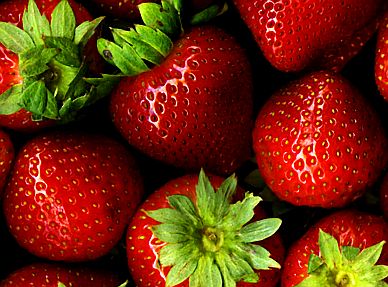
Yummy looking strawberries, but they may cause an allergic reaction.
Strawberry allergies – what really happens?
People who have an allergy to strawberries often ask about the biological processes that are occurring in their bodies. The protein that causes the allergy has been identified as “Fra a1”or Fragaria allergen 1, and this allergen, according to a study by Christian Seutter von Loetzen et al, is found in ripe red strawberries and absent in white ones. Now, what happens is that in people who have an intolerance to strawberries, the protein “Fra a1” is not recognized by the immune system. This causes the formation of Ig E antibodies that latch on to this allergen and cause the release of histamine and other inflammation causing substances. The whole cascade of released substances that follows leads to the symptoms observed in people who have allergic reactions to strawberries.
Symptoms of Strawberry Allergy
The signs of strawberry allergy usually appear within two hours of ingestion and primarily manifest on the mouth or throat. A strawberry allergy reaction often begins with tingling around the mouth area that may be followed by swelling of the lips, tongue or throat. Swelling of the lips and tongue can impede speech if serious and out of control swelling of throat can close up respiratory passages and make it difficult to breathe. For this reason it is essential to seek treatment for strawberry allergies, especially if you can feel your throat closing up.
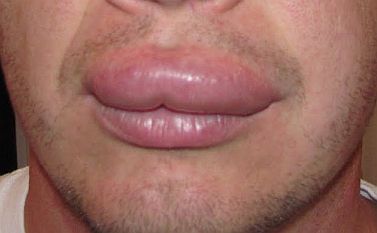
A strawberry allergy reaction may cause swollen lips.
Strawberry allergy rash is also one of the symptoms. The histamine released due to the allergic reaction can cause widespread swelling of the skin and may also lead to red blotches and strawberry allergy hives. It can lead to the formation of itchy, red patches of skin and can even cause watery eyes and a stuffy nose. Many people who are unaware that they are allergic to strawberry first find out about their allergy when they get a rash from strawberries. A strawberry allergy test can also be done to confirm this diagnosis and then proper prevention must be followed to avoid any symptoms.
A strawberry allergy can also give rise to some gastrointestinal symptoms. As the body is not reacting well to the ingested strawberries, nausea, vomiting and abdominal bloating may accompany an upset stomach. In severe cases, the allergy can also cause abdominal cramps and diarrhoea. Even though anaphylaxis is very rarely seen in patients with strawberry allergy it is best to be prepared for anything. A rapid pulse, sudden drop in blood pressure or loss of consciousness are warning signs to rush for medical attention. In such cases of emergency you can use an Epi pen to bring quick relief to the patient.
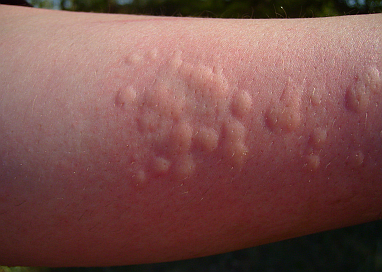
Picture of an arm with mild strawberry allergy. Hives can break out as an allergic reaction to strawberries.
Strawberry Allergy Treatment
To battle some of the symptoms of a strawberry allergy you can consult your doctor for treatment. Usually anti-histamine tablets are prescribed for throat discomfort, sneezing or rhinitis. As for the skin symptoms, hydrocortisone creams or topical anti-histamine is commonly prescribed to patients with strawberry allergies. In the event of an emergency when the patient is rushed to the hospital with difficulty in breathing the doctor will administer an epinephrine injection which will bring quick relief to the patient. If you have experienced an anaphylactic shock before or swelling of the throat you can ask your doctor to prescribe you an Epi-pen in case of an emergency. The disadvantage with these medications is that most of them can cause side effects like irritability, dry mouth and drowsiness. However, they are life savers and should be carried with you in case you get a severe reaction.
For those with mild strawberry allergy you might consider using natural remedies that are free of nasty side effects and easy enough to put together any time at home.
Natural Remedies for Strawberry Allergy
1. Avoid Strawberries at all cost
Why worry about treating your allergy when you can just avoid it altogether? It may be pretty difficult at the start but once you have informed your friends and family of your allergy, they can help you stay in a strawberry free environment. Not only must you avoid strawberries, jams, cakes, but juices must also be avoided. Some lotions, lip glosses and air fresheners also contain strawberry so if you suddenly start sneezing make sure to inquire whether a strawberry spray has been used. It is also wise to wear a medical alert necklace in case of an emergency.
2. Use a cold compress
The swelling brought on by an allergy on the lips, face or general skin can be alleviated with a cold compress. Some people have experienced relief with this method.
3. Apply an Aloe Vera salve
Hives or itchy skin can be treated by an aloe vera salve. Just rub some gently on the affected area and sit back as the miraculous soothing effect of aloe vera clears up your skin situation. Do not put the salve on your lips as some aloe vera gels should not be ingested.
4. Sip on some green tea
You can always rely on easy to make herbal concoctions like green tea or chamomile tea that have an anti-histamine effect which may aid in relieve many of the symptoms of strawberry allergy including rashes, itching, hives and sore throat.
If you have suggestions to any kind of treatment that have helped you to relief a strawberry allergy, please share it in the comments section.
The post Strawberry Allergy appeared first on Food Pyramid.
]]>The post Does Fast Food Cause Obesity? appeared first on Food Pyramid.
]]>The Body Mass Index (BMI) is the calculation of what we consider to be healthy and unhealthy weights. A BMI from 18.5 to 25 is considered to be in the healthy range. Any person with a BMI equal to or greater than 30 is considered to be obese. This means that according to obesity reviews in literature searches, more than 72 million people have a BMI greater than 30.
In most parts of the developing world, people are more likely to be captivated by various forms of modern day technology which potentially decrease physical activity. Recent studies have directly linked television-watching, for instance, to the rise of obesity. But does fast food cause obesity too?
There is no single cause for obesity as people can either be genetically inclined to be obese or can become obese because of a combination of genetic and environmental factors. However, there are many factors that could accelerate this inclination to obesity in human beings. Is fast food is a determining factor? And if it is, how does fast food cause obesity?
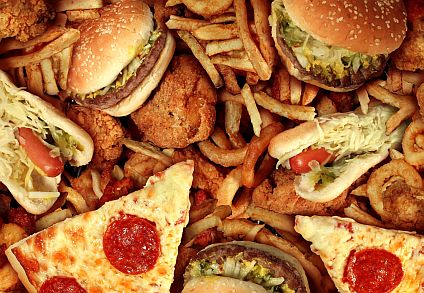
How Fast Food may be a Determining Factor for Obesity:
1. High Fat Content (High Calories): Most fast food restaurants are more concerned with their sales than the health of their customers, therefore they tend to use cheaper or subsidized food products (for instance rice, wheat, corn, and soybeans) which contain higher calories (and/or higher fat content) than the healthier options with lower calories. The U.S Government paid $12.3 billion to farmers in 2009 to enable them to meet the demands of these foods from fast food companies. The calories an average person should consume in one meal should not be greater than roughly 660 calories. However, one meal (including a cup of soda) in most fast food restaurants goes well and beyond 660 calories. Also, High-Fructose Corn Syrup (HFCS) is the number one source of calories in the United States. It is found in soda and is synthesized from the most heavily subsidized crop – corn. HFCS contains 24% water and the rest sugars. According to the Center for Disease and Control, in the 40 years since HFCS was introduced, obesity has drastically increased.²
2. Bad Nutrient Quality: A lot of fast foods have almost zero nutrient quality. If you buy a meal from one of the popular fast food restaurants, always take a look at the nutritional labels (if present). You will find out that most of the calories listed have no nutritional value. Also foods that are too high in the nutrient sodium should be avoided as too much consumption of sodium (more than 2,300mg/day) can lead to congestive heart failure, cirrhosis, and kidney disease, especially in those who are obese.
3. Large Portion Size: Portion sizes are very important to maintain a BMI within the healthy range. Most people don’t keep track of their portion sizes, but the recommended amounts per meal can be found under the “serving size” information on grocery packages or restaurant meal menus. Over-sized portion sizes contribute greatly to obesity.
Conclusion
Is fast food causing obesity? The answer to that depends on the type of fast food. If it has high fat content, bad nutrient quality, and if it is consumed in extremely large portion sizes, then yes, it will cause obesity.
References:
1. Duffey KJ, Popkin BM (2011) Energy Density, Portion Size, and Eating Occasions: Contributions to Increased Energy Intake in the United States, 1977–2006. PLoS Med 8(6): e1001050. doi:10.1371/journal.pmed.1001050
2. Parker H. A Sweet Problem: Princeton Researchers Find that High-Fructose Corn Syrup Prompts Considerably More Weight Gain [Internet]. Princeton (New Jersey). The Trustees of Princeton University; 2010 March 22. Available from: http://www.princeton.edu/main/news/archive/S26/91/22K07/
The post Does Fast Food Cause Obesity? appeared first on Food Pyramid.
]]>The post Integrated Charities: A look at Modern Hunger Crossroads appeared first on Food Pyramid.
]]>When it seems everything else in the world is changing daily, the problem of hunger is stubborn in its consistency. It’s a condition human kind has been dealing with as far back as we can remember. Campaigns are regularly launched, organizations are established, resources are dispensed and yet, it seems that hunger is a problem that simply refuses to go away.
The United States faces a unique hurdle when it comes to hunger. We are a land of plenty, yet it is estimated that 1 in 6 Americans struggles with hunger on a daily basis. Our excess has reached a point that as a society, we are moving towards mass trends of fad dieting in an endless string of attempts to battle obesity in adults and children alike. When the hungry and the full stand side by side in a country, how is it possible to address both needs at the same time?

Where tradition meets innovation
The answer to that may lie at the crossroads of well-tested systems and new ideas. Those individuals out in the field who are looking for solutions are asking themselves the tough question of whether or not it’s possible to come to a place where hunger, nutrition and health can exist in harmony for the greater good.
Organizations that work to end hunger face a major hurdle when it comes to nutrition. Too often those living at or below the poverty line are forced to resort to fatty, overly processed food because of the price variable. Similarly, those fighting obesity struggle with calorie-packed foods that are easily accessible and overly abundant at fast-food chains across the nation. The bigger problem reveals itself when these two worlds collide.
What we now face is a growing group of people struggling to stay financially afloat and dealing with chronic health struggles. Recently, several groups have attempted to find a way to forge a solution that speaks to both of these issues with a common message. In doing so it’s becoming useful to use new ideas, traditional methods and creative combinations of the two.
Eat this, not that – new age nutrition
A prime example of revamping a system that already exists to make it efficiently modern and effective is the case of the book Eat This Not That! The Best (& Worst!) Foods in America!: The No-Diet Weight Loss Solution. Originally published in 1997, David Zinczenko along with the help of Matt Goulding decided to bring the material up-to-date in 2010. They coined their finished product the no diet weight loss solution.
At first glance, this book may seem like just another fad diet book on the shelf. A closer look would prove it to be otherwise. In fact, Eat This Not That is well equipped to take on several detrimental forces at once. The book lays out statistics, facts and most importantly, alternatives to unhealthy food choices the general public is likely to make. Investigative research into American’s top fast food chains and restaurants gave these authors the proof they needed to pen the nutrition labels companies would rather you didn’t have access to.
It’s important to note that this is not just a book based on scare tactics for the sake of weight loss. The authors follow up their terrifying facts with healthy or at least healthier choices that can be made when preparing certain dishes yourself or visiting your favorite culinary hot spot. What makes this initiative so valuable is the fact that it appeals to people across the economic board.
Those who live well above the poverty line but struggle with health issues will be able to find affordable and easy solutions to everyday predicaments. Where money is not an issue, those same people may be encouraged to make alternative choice based on the information available to them. Those who do live at or below the poverty line are able to use the information to make more informed decisions even if it’s necessary for them to sustain themselves with less nutritious choices. By offering alternatives that everyone can put into action individually, Eat This Not That sets a standard for self-sufficient and sustainable nutrition.
To date, there are several sub-publications of the book that are focused on children’s health, supermarket shopping and restaurant swaps. This integrated system of information allows for individuals to apply it uniquely to their own situations and in doing so, make lasting change in their lives.
Feeding America – through change
Established in 1976 and headquartered in Chicago, Illinois, Feeding America is a non-profit organization that aims to provide domestic hunger relief. As a whole, the organization functions as a network of hundreds of food banks and charitable support systems. When added together, Feeding America has earned the title of largest hunger-relief charity in the United States.
While they have been around for several decades, those who work for Feeding America understand the necessity for change in order to be the most effective. They too have set out to develop sustainable and nutritious solutions to hunger and health deficiencies across the country.
In October 2011, Feeding America partnered with Wal-Mart, Sesame Street and Brad Paisley to host a special titled “Growing Hope Against Hunger.” The TV special introduced viewers to Lily, a new Muppet whose family struggles with hunger–but it didn’t stop there. The program went on to feature the stories of actual families who deal with issues of hunger on a daily basis and resources and strategies they utilize to get by.
By partnering with Sesame Street, Feeding America made the effort to reach a younger audience who has the ability to carry lessons on nutrition and social issues into their futures. By highlighting real families who struggle with hunger, the organization is providing resources that viewers can take into their own hands and utilize those strategies independently.
Taking on the future
While hunger-relief charities and diet fads of the past set out with good intentions, their methods are outdated. Society is merging into a pool of needs that require more than one or two solutions. The path to reaching an integrated society in economic turmoil is by paving traditional paths with modern skills. Issues like hunger and obesity have come to a cross roads, and those who suffer don’t need a hand out; they just need a helping hand in the right direction. By recognizing the strength of individuals, and offering tools to help them achieve success, charitable organizations will make a long-lasting difference across the nation. Do you think hunger-relief charities are making strides forward with these innovative solutions?
The post Integrated Charities: A look at Modern Hunger Crossroads appeared first on Food Pyramid.
]]>